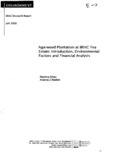Agarwood plantation at BRAC tea estate: introduction, environmental factors and financial analysis
Citation
Akter, N., & Neelim, A. Z. (2008, June). Agarwood plantation at BRAC tea estate: introduction, environmental factors and financial analysis. Research Reports (2008): Economic Studies, Vol - XXVI, 1–23.Abstract
The Aquillaria malaccensis (known as agar) produces agarwood which is used in perfumes,
incense and medicines, and thus, can be extremely valuable. Excessive harvesting of agarwood
has made this species threatened. Considering its conservation value and economic benefit
BRAC has started agarwood plantation at Kaiyachara Tea Estate from July. 2007. At Kaiychara
tea estate, a plantation of about 17 acres has been created, where 83,400 agar seedlings have
been planted between August and October 2007. In addition, 700,000 agar seedlings have been
planted in two nurseries, namely 'Kaiya' and 'Sirgasia', at Kaiyachara tea estate. The survival
rate of young seedlings was around 95%, which can be considered impressive. The habitat
provided by the environment in the tea estate, along with the microclimatic and soil condition
in that area is favourable for growing agar plants. Initially, the BRAC tea estate plans to plant
50 acres of land with agar plant, after which agarwood harvesting would take place after 12
years. Assuming 90% survival rate and 2 kg premium quality agarwood production per plant
the estimated investment related to plantation would be Tk. 145,497,198 and total return would
be Tk. 60,907,155,348 with the rate of return 41.861%. However, this high rate of return is an
underestimate given the environmental benefits of this plantation would generate. The
establishment of this plantation would also be significant in terms of the environmental
conservation of this endangered species, as well as provide a carbon sink to reduce green house
gases. Furthermore, there are potential opportunities that would arise in the future for
improving the livelihoods of poor people in the region by providing income generating means.
This report was prepared after field investigation and laboratory analysis and contains
suggestions regarding proper management of the plantation as well as further research.

